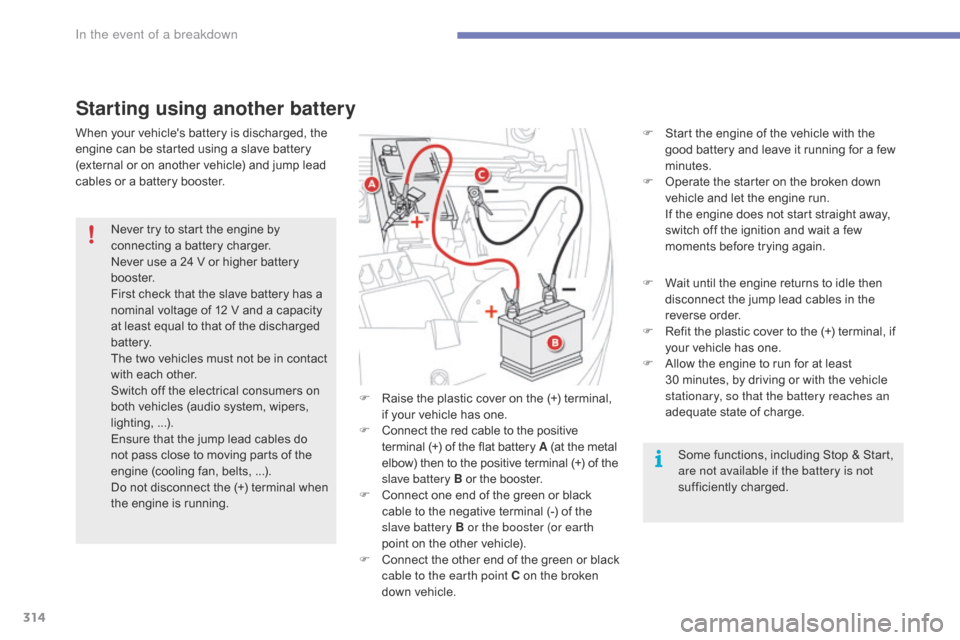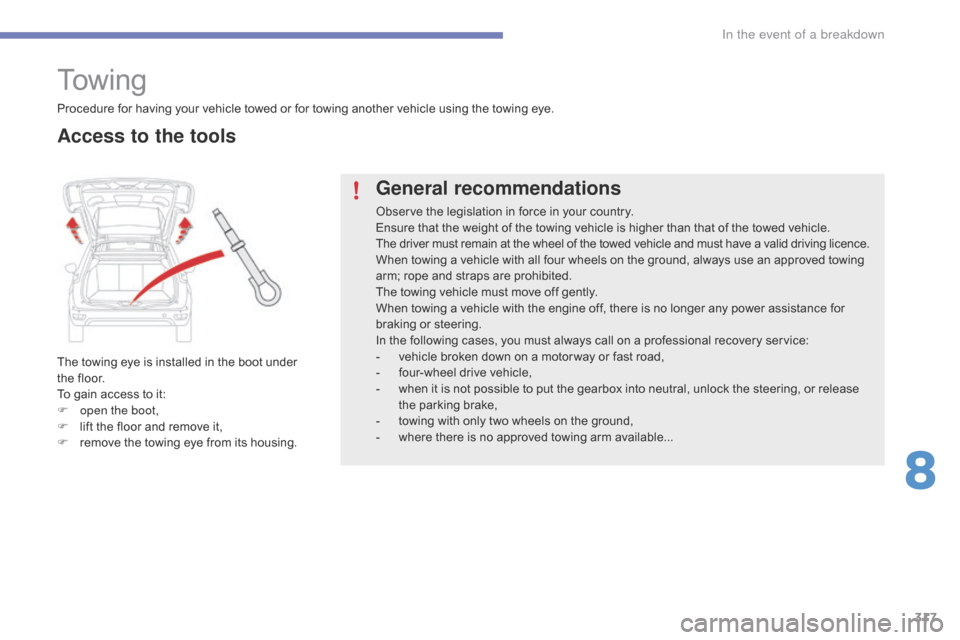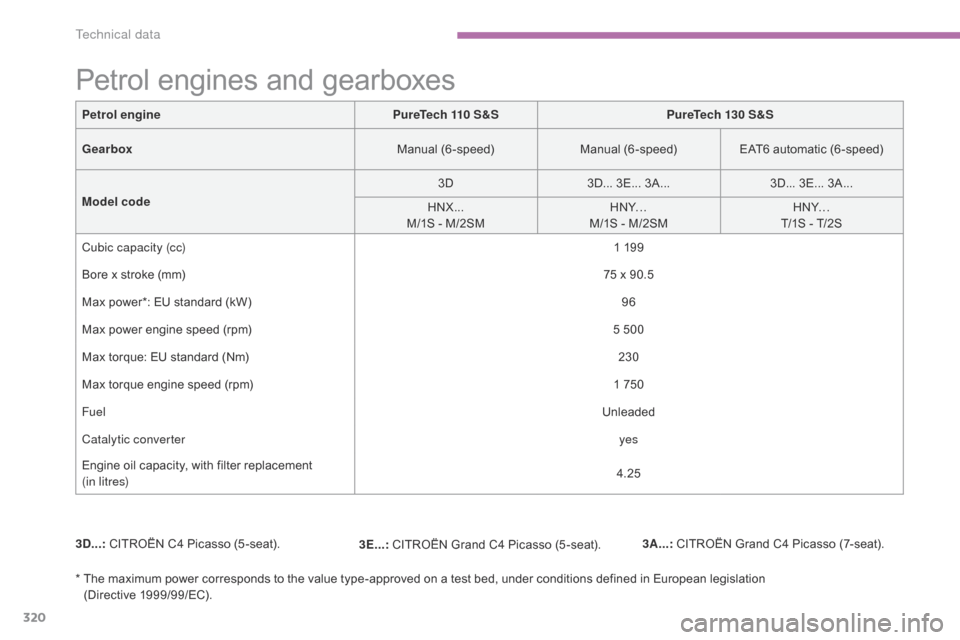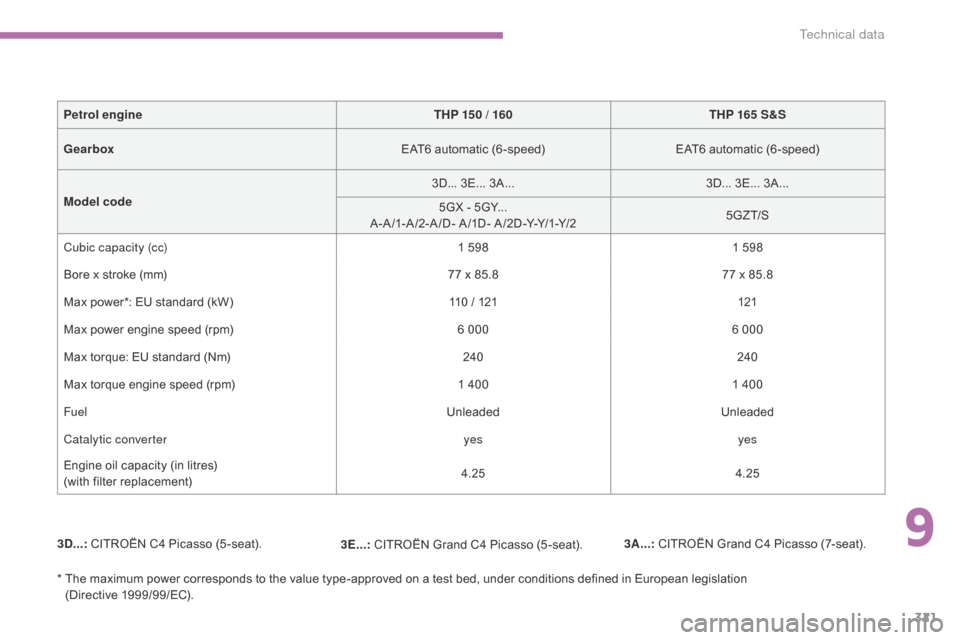engine Citroen GRAND C4 PICASSO RHD 2016 2.G Owner's Manual
[x] Cancel search | Manufacturer: CITROEN, Model Year: 2016, Model line: GRAND C4 PICASSO RHD, Model: Citroen GRAND C4 PICASSO RHD 2016 2.GPages: 523, PDF Size: 13.63 MB
Page 316 of 523

314
F Start the engine of the vehicle with the g
ood battery and leave it running for a few
m
inutes.
F
O
perate the starter on the broken down
v
ehicle and let the engine run.
I
f the engine does not start straight away,
s
witch off the ignition and wait a few
m
oments before trying again.
F
W
ait until the engine returns to idle then
d
isconnect the jump lead cables in the
r
everse
o
rder.
F
R
efit the plastic cover to the (+) terminal, if
y
our vehicle has one.
F
A
llow the engine to run for at least
3
0 minutes, by driving or with the vehicle
s
tationary, so that the battery reaches an
adequate
state of charge.
Starting using another battery
Some functions, including Stop & Start, are not available if the battery is not
sufficiently
c
harged.
F
R
aise
the
plastic
cover
on
the
(+)
terminal,
i
f
your
vehicle
has
one.
F
C
onnect
the
red
cable
to
the
positive
t
erminal
(+)
of
the
flat
battery
A
(at
the
metal e
lbow)
then
to
the
positive
terminal (+)
of
the s
lave battery B
or
the
booster.
F
C
onnect
one
end
of
the
green
or
black
c
able
to
the
negative
terminal
(-)
of
the
s
lave battery B or the booster (or earth
point
on
the
other
vehicle).
F
C
onnect
t
he
o
ther
e
nd
o
f
t
he
g
reen
o
r
b
lack
c
able to the earth point C
on
the
broken
d
own
vehicle.
Never
try
to
start
the
engine
by
c
onnecting
a
battery
charger.
Never
use
a
24
V
or
higher
battery
b
o o s t e r.
First
check
that
the
slave
battery
has
a
n
ominal
voltage
of
12
V
and
a
capacity
a
t
least
equal
to
that
of
the
discharged
b
attery.
The
two
vehicles
must
not
be
in
contact
w
ith
each
other.
Switch
off
the
electrical
consumers
on
b
oth
vehicles
(audio
system,
wipers,
l
ighting, ...).
Ensure
that
the
jump
lead
cables
do
n
ot
pass
close
to
moving
parts
of
the
e
ngine
(cooling
fan,
belts, ...).
Do
not
disconnect
the
(+)
terminal
when
t
he
engine
is
running.
When
your
vehicle's
battery
is
discharged,
the
e
ngine
can
be
started
using
a
slave
battery
(
external
or
on
another
vehicle)
and
jump
lead
c
ables
or
a
battery
booster.
In the event of a breakdown
Page 318 of 523

316
The Stop & Start system may not be operational during the trip following the
f
irst engine start.
In
this case, the system will only be
a
vailable again after a continuous
p
eriod of immobilisation of the vehicle,
a
period which depends on the ambient
t
emperature and the state of charge of
t
he battery (up to about 8 hours).
Do
not
force
the
lever
as
locking
will
n
ot
be
possible
if
the
clamp
is
not
p
ositioned
correctly;
start
the
procedure
ag
ain.
Disconnecting the (+) terminal
F
Ra
ise the lever A fully to release the
clamp B.
Reconnecting the (+) terminal
F
P
osition
the
open
clamp
B of the cable on
the
positive
post
(+)
of
the
battery.
F
P
ress
down
on
the
clamp
to
position
it
c
orrectly
on
the
battery
post.
F
L
ock
the
clamp
by
lowering
the
lever
A .
Disconnecting the battery
In order to maintain an adequate state o
f charge for starting the engine, it is
r
ecommended that the battery be disconnected
i
f the vehicle is taken out of service for a long
p
eriod.
Before
disconnecting the battery:
F
c
lose all openings (doors, boot, windows,
r
oof),
F
s
witch off all electrical consumers (audio
s
ystem, wipers, lighting, ...),
F
s
witch off the ignition and wait for
f
our minutes.
At
the battery, detach just the (+) terminal.Following reconnection of the battery
Following reconnection of the battery, switch on the ignition and wait 1 minute before starting to
p
ermit initialisation of the electronic systems.
H
owever, if problems remain following this
o
peration, contact a CITROËN dealer or a
q
ualified
w
orkshop.
Referring
to the corresponding section, you
m
ust
y
ourself
r
einitialise
(
depending
o
n
ve
rsion):
-
t
he remote control key,
-
t
he electric blind(s),
-
...
Quick release terminal
In the event of a breakdown
Page 319 of 523

317
To w i n g
The towing eye is installed in the boot under the floor.
To
gain access to it:
F
o
pen the boot,
F
l
ift the floor and remove it,
F
r
emove the towing eye from its housing.
General recommendations
Observe the legislation in force in your country.
E nsure that the weight of the towing vehicle is higher than that of the towed vehicle.
The
driver must remain at the wheel of the towed vehicle and must have a valid driving licence.
When
towing a vehicle with all four wheels on the ground, always use an approved towing
a
rm; rope and straps are prohibited.
The
towing vehicle must move off gently.
When
towing a vehicle with the engine off, there is no longer any power assistance for
b
raking or steering.
In
the following cases, you must always call on a professional recovery service:
-
v
ehicle broken down on a motor way or fast road,
-
f
our-wheel drive vehicle,
-
w
hen it is not possible to put the gearbox into neutral, unlock the steering, or release
t
he parking brake,
-
t
owing with only two wheels on the ground,
-
w
here there is no approved towing arm available...
Procedure
for
having
your
vehicle
towed
or
for
towing
another vehicle using the towing eye.
Access to the tools
8
In the event of a breakdown
Page 320 of 523

318
Towing another vehicle
F On the rear bumper, unclip the cover by p
ressing at the bottom.
F
S
crew the towing eye in fully.
F
I
nstall the towing bar.
F
S
witch on the hazard warning lamps on
b
oth vehicles.
F
M
ove off gently, drive slowly and for a short
di
stance.
F
O
n
the
front
bumper,
unclip
the
cover
by
p
ressing
on
the
left.
F
S
crew
the
towing
eye
in
fully.
F
I
nstall
the
towing
bar.
F
P
lace
the
gear
lever
in
neutral
(position
N
with
an
automatic
gearbox).
Towing your vehicle
Failure to observe this instruction could r esult in damage to certain components
(
braking, transmission...) and the
a
bsence of braking assistance the next
t
ime the engine is started.
F
U
nlock the steering by turning the key
i
n
the ignition one notch and release the
par
king
b
rake.
F
S
witch on the hazard warning lamps on
b
oth vehicles.
F
M
ove off gently, drive slowly and for a short
di
stance.
In the event of a breakdown
Page 321 of 523

319
Running out of fuel (Diesel)
On vehicles fitted with Diesel engines, the fuel system must be primed if you run out of fuel.
For all versions other than BlueHDi, refer to the
corresponding
engine compartment view.Other HDi engines
(except BlueHDi version)
For
more
information
on
Diesel misfuel
prevention ,
refer
to
the
corresponding
s
ection.
If
the
engine
does
not
start
first
time,
d
on't
keep
trying
but
start
the
procedure
a
gain
from
the
beginning.
BlueHDi engines
F Fill the fuel tank with at least five litres of D
iesel.
F
S
witch on the ignition (without starting the
e
ngine).
F
W
ait around 6 seconds and switch off the
ig
nition.
F
R
epeat the operation 10 times.
F
O
perate the starter to run the engine.F
A
dd at least five litres of Diesel fuel to the
t
ank.
F
O
pen the bonnet.
F
I
f necessary, unclip the styling cover for
a
ccess to the priming pump.
F
S
queeze and release the priming pump
r
epeatedly until resistance is felt (there
m
ay be resistance at the first press).
F
O
perate the starter to start the engine
(
if the engine does not start at the first
a
ttempt, wait around 15 seconds before
t
rying
ag
ain).
F
I
f the engine does not start after a few
a
ttempts, operate the priming pump again
t
hen start the engine.
F
R
efit the styling cover and clip it in place.
F
C
lose the bonnet.
8
In the event of a breakdown
Page 322 of 523

320
Petrol enginePureTech 110 S&SPureTech 130 S&S
Gearbox Manual
(
6-speed)Manual
(
6-speed)EAT6
automatic (6 -speed)
Model code 3D
3D...
3
E...
3
A...3D...
3
E...
3
A...
HNX...
M/1S
- M/2SMHNY…
M/1S
- M/2SMHNY…
T/1S
- T/2S
Cubic capacity (cc) 1
199
Bore
x stroke (mm) 75
x 90.5
Max
power*: EU standard (kW) 96
Max
power engine speed (rpm) 5
500
Max
torque: EU standard (Nm) 230
Max
torque engine speed (rpm) 1
750
Fuel Unleaded
Catalytic converter yes
Engine
oil capacity, with filter replacement
(in litres) 4.25
Petrol engines and gearboxes
3D...:
CITROËN C4 Picasso (5 -seat). 3A...: CITROËN Grand C4 Picasso (7-seat).
3E...: CITROËN Grand C4 Picasso (5 -seat).
*
T
he maximum power corresponds to the value type-approved on a test bed, under conditions defined in European legislation
(Directive
1
999/99/EC).
Technical data
Page 323 of 523

321
3D...: CITROËN C4 Picasso (5 -seat). 3A...: CITROËN Grand C4 Picasso (7-seat).
3E...: CITROËN Grand C4 Picasso (5 -seat).
*
T
he maximum power corresponds to the value type-approved on a test bed, under conditions defined in European legislation
(Directive
1
999/99/EC).
Petrol engine
THP 150 / 160THP 165 S&S
Gearbox EAT6 automatic (6 -speed)
EAT6 automatic (6 -speed)
Model code 3D...
3
E...
3
A...
3D...
3
E...
3
A...
5GX - 5GY...
A-A/1-A/2-A/D-
A/
1D-
A/
2D-Y-Y/1-Y/2
5G Z T/S
Cubic capacity (cc) 1 598
1 598
Bore x stroke (mm)
77 x 85.8
77 x 85.8
Max power*: EU standard (kW)
110 / 121
121
Max power engine speed (rpm)
6 000
6 000
Max torque: EU standard (Nm)
240 240
Max torque engine speed (rpm)
1 400
1 400
Fuel UnleadedUnleaded
Catalytic converter yesyes
Engine oil capacity (in litres)
(with filter replacement)
4.25
4.25
9
Technical data
Page 324 of 523

322
* The weight values are calculated with a towbar.
* * The kerb weight is equal to the unladen weight + driver (75 kg).
***
T
he weight of the braked trailer can be increased, within the GTW limit, if the GV W of the towing vehicle is reduced by an equal amount; warning,
t
owing using a lightly loaded towing vehicle may have an adverse effect on its road holding.
Petrol engine
PureTech 110 S&S*PureTech 130 S&S*
Gearbox Manual
(
6-speed)
Manual
(
6-speed)
EAT6 automatic (6 -speed)
Model code 3D
3D...
3
E...
3
A...
3D...
3
E...
3
A...
HNX...
M/1S - M/2SM
HNY…
M/1S - M/2SM
HNY…
T/1S - T/2S
Unladen weight
1 280
1 280 - 1 295 - 1 297
1 298 - 1 315 - 1 317
Kerb weight**
1 355
1 355 - 1 370 - 1 372
1 373 - 1 390 - 1 392
Gross vehicle weight (GV W)
1 905
1 905 - 2 075 - 2 125
1 918 -1 957 - 2 136
Gross train weight (GTW)
o
n a 12% gradient
3 035
3 175 - 3 125 - 3 175
3 188 - 3 007 - 3 186
Braked trailer (within the GTW limit)
o
n a 10% or 12% gradient
1 130
1 270 - 1 050 - 1 050
1 270 - 1 050 - 1 050
Braked trailer***
(with load transfer within the GTW limit)
1 330
1 470 - 1 350 - 1 350
1 470 - 1 350 - 1 350
Unbraked
t
railer
640640 - 647 - 648
640 - 647 - 648
Recommended nose weight
707070
Petrol weights and towed loads (in kg)
The GTW and towed load values indicated are valid up to a maximum altitude of 1 000 metres; the towed load mentioned must be reduced by 10 % for e
ach additional 1 000 metres of altitude.
When
towing, the speed must never exceed 60 mph (100 km/h) (comply with the legislation in force in your country).
High
ambient temperatures may result in a reduction in the per formance of the vehicle to protect the engine; if the ambient temperature is above 37 °C,
l
imit the towed load.
Technical data
Page 325 of 523

323
The weight of the braked trailer can be increased, within the GTW limit, if the GV W of the towing vehicle is reduced by an equal amount; warning, towing using a lightly loaded towing vehicle may have an adverse effect on its road holding.
When
towing, the speed must never exceed 60 mph (100 km/h) (comply with the legislation in force in your country).
High
ambient temperatures may result in a reduction in the per formance of the vehicle to protect the engine; if the ambient temperature is above 37 °C,
l
imit the towed load..
Petrol engine
THP 150 / 160THP 165 S&S
Gearbox EAT6 automatic (6 -speed)
EAT6 automatic (6 -speed)
Model code 3D...
3
E...
3
A...
3D...
3
E...
3
A...
5GX - 5GY...
A-A/1-A/2-A/D-
A/
1D-
A/
2D-Y-Y/1-Y/2
5G Z T/S
Unladen weight
1 405 - 1 428 - 1 430
1 310 - 1 318 - 1 320
Kerb weight*
1 480 - 1 503 - 1 505
1 385 - 1 393 - 1 395
Gross vehicle weight (GV W)
1 940 - 2 140 - 2 160
1 930 - 2 100 - 2 150
Gross train weight (GTW)
o
n a 12% gradient
2 740 - 2 940 - 2 960
3 330 - 3 350 - 3 350
Braked trailer (within the GTW limit)
o
n a 10% or 12% gradient
800
1 400 - 1 250 - 1 200
Braked trailer**
(with load transfer within the GTW limit)
800
1 600 - 1 550 - 1 500
Unbraked
t
railer
600685 - 690 - 690
Recommended nose weight
7070
* The kerb weight is equal to the unladen weight + driver (75 kg).
**
T
he weight of the braked trailer can be increased, within the GTW limit, if the GV W of the towing vehicle is reduced by an equal amount; warning,
t
owing using a lightly loaded towing vehicle may have an adverse effect on its road holding.
9
Technical data
Page 326 of 523

324
Diesel engines and gearboxes
.../S: e-HDi model fitted with Stop & Start.
3 D...: CITROËN C4 Picasso (5 -seat).3E...:
CITROËN Grand C4 Picasso (5 -seat).
3A...: CITROËN Grand C4 Picasso (7-seat).
Diesel engine
HDi 115BlueHDi 100 S&S
Gearbox Manual
(
6-speed)
Manual
(
6-speed)
Model code 3D...
3
E...
3
A...
3D...
3
E...
3
A...
9HC... 8 - 8/1
BHY...
6/1S - 6/2SM
Cubic capacity (cc) 1 560
1 560
Bore x stroke (mm)
75 x 88.3
75 x 88.3
Max power*: EU standard (kW)
85 73
Max power engine speed (rpm)
3 600
3 750
Max torque: EU standard (Nm)
270 254
Max torque engine speed (rpm)
1 750
1 750
Fuel DieselDiesel
Catalytic converter yesyes
Particle filter noyes
Engine oil capacity, with filter replacement
(in litres) 3.75
3.75
*
T
he maximum power corresponds to the value type-approved on a test bed, under conditions defined in European legislation
(Directive
1
999/99/EC).
Technical data